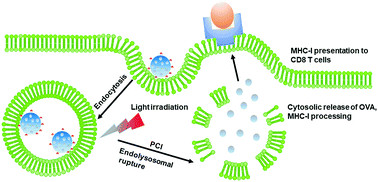当前位置:
X-MOL 学术
›
J. Mater. Chem. B
›
论文详情
Our official English website, www.x-mol.net, welcomes your
feedback! (Note: you will need to create a separate account there.)
Enhanced MHC-I antigen presentation from the delivery of ovalbumin by light-facilitated biodegradable poly(ester amide)s nanoparticles
Journal of Materials Chemistry B ( IF 6.1 ) Pub Date : 2018-02-21 00:00:00 , DOI: 10.1039/c7tb03233a Ying Ji 1, 2, 3 , Jihui Zhao 4, 5, 6 , Chih-Chang Chu 1, 2, 2, 3, 7
Journal of Materials Chemistry B ( IF 6.1 ) Pub Date : 2018-02-21 00:00:00 , DOI: 10.1039/c7tb03233a Ying Ji 1, 2, 3 , Jihui Zhao 4, 5, 6 , Chih-Chang Chu 1, 2, 2, 3, 7
Affiliation

|
The generation of CD8 T cells is crucial in adaptive immunity against cancer and many infectious diseases. Vaccines aimed to stimulate CD8 T cell response typically become ineffective because the antigens are subject to sequestration in endocytic compartments, instead of being delivered cytosolically for MHC-I processing and presentation. In this study, a nano-carrier (Arg–Phe-PEA(AP) nanoparticles) for ovalbumin (OVA) was developed from arginine- and phenylalanine-based poly(ester amide)s, which further formed an electrostatic complex with AlPcS2a, a typical photosensitizer for photochemical internalization (PCI) strategies. The nanocarrier significantly enhanced the internalization efficiency by dendritic cells of both OVA and AlPcS2a. The photochemical interruption of endocytic compartments by the AlPcS2a photosensitizer complexed in the nanocarrier enabled the light-facilitated endosomal escape of OVA. MHC-I presentation and CD8 T cell response were elicited by OVA-loaded Arg–Phe-PEA(AP) nanoparticles when light irradiation was applied at 660 nm. The light-facilitated delivery of OVA was dependent on the light dose and the concentration of the photosensitizer, both in vitro and in vivo. The optimized stimulation of MHC-I response demonstrated the potency of this light-facilitated nano-platform for CD8 T cell-inducing vaccination.
中文翻译:

光促进的可生物降解的聚(酯酰胺)s纳米颗粒从卵清蛋白的递送中增强的MHC-1抗原呈递
CD8 T细胞的生成对于抵抗癌症和许多传染性疾病的适应性免疫至关重要。旨在刺激CD8 T细胞反应的疫苗通常变得无效,因为这些抗原被隔离在内吞区隔中,而不是通过细胞质递送用于MHC-1加工和呈递。在这项研究中,从精氨酸和苯丙氨酸基的聚(酯酰胺)中开发了用于卵清蛋白(OVA)的纳米载体(Arg-Phe-PEA(AP)纳米颗粒),该载体进一步与AlPcS2a形成了静电络合物。用于光化学内在化(PCI)策略的典型光敏剂。纳米载体显着提高了OVA和AlPcS2a的树突状细胞的内在化效率。纳米载体中复合的AlPcS2a光敏剂对胞吞区的光化学破坏使光促性的OVA内体逃逸成为可能。当在660 nm处进行光照射时,OVA负载的Arg–Phe-PEA(AP)纳米粒子会引起MHC-1的表达和CD8 T细胞应答。OVA的光促递送取决于光剂量和光敏剂的浓度,两者体外和体内。对MHC-1反应的优化刺激证明了这种光促化的纳米平台对CD8 T细胞诱导疫苗的效力。
更新日期:2018-02-21
中文翻译:

光促进的可生物降解的聚(酯酰胺)s纳米颗粒从卵清蛋白的递送中增强的MHC-1抗原呈递
CD8 T细胞的生成对于抵抗癌症和许多传染性疾病的适应性免疫至关重要。旨在刺激CD8 T细胞反应的疫苗通常变得无效,因为这些抗原被隔离在内吞区隔中,而不是通过细胞质递送用于MHC-1加工和呈递。在这项研究中,从精氨酸和苯丙氨酸基的聚(酯酰胺)中开发了用于卵清蛋白(OVA)的纳米载体(Arg-Phe-PEA(AP)纳米颗粒),该载体进一步与AlPcS2a形成了静电络合物。用于光化学内在化(PCI)策略的典型光敏剂。纳米载体显着提高了OVA和AlPcS2a的树突状细胞的内在化效率。纳米载体中复合的AlPcS2a光敏剂对胞吞区的光化学破坏使光促性的OVA内体逃逸成为可能。当在660 nm处进行光照射时,OVA负载的Arg–Phe-PEA(AP)纳米粒子会引起MHC-1的表达和CD8 T细胞应答。OVA的光促递送取决于光剂量和光敏剂的浓度,两者体外和体内。对MHC-1反应的优化刺激证明了这种光促化的纳米平台对CD8 T细胞诱导疫苗的效力。











































 京公网安备 11010802027423号
京公网安备 11010802027423号